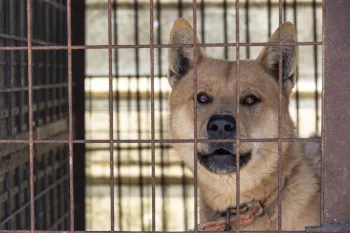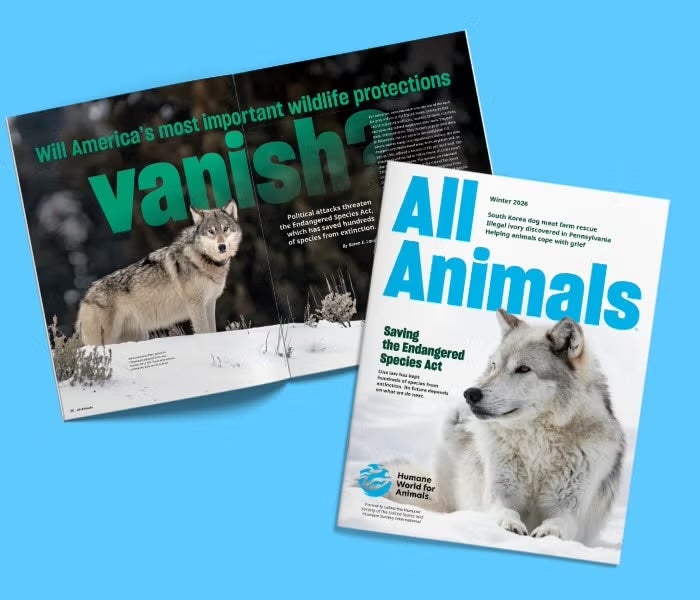Was I going to burst into tears once I stepped onto the farm? Would I dissociate and feel nothing? These were the thoughts I had leading up to my first dog meat farm rescue. I had seen footage from the farm in South Korea, but I wondered how it would feel to actually be there and hear the dogs crying for help, smell the feces piled up under their cages and see the trauma in their eyes.
On May 4, I took a 15-hour flight to South Korea where I joined my colleagues from Humane World for Animals to rescue dogs from a dog meat farm. Cheongju authorities were shutting down this farm for operating illegally. As a video producer for Humane World, my job for this rescue was to film and document the process.
The rescue took place over two days. On the first day, we went to the farm to feed the dogs, give them water, check for microchips that the team previously inserted (which they needed to have to fly to the U.S.), build crates and walk through the rescue plan for removing the dogs. As soon as I stepped on the farm, I felt overwhelmed. My eyes welled up as I watched the dogs in their cages, but then I felt a sense of relief. We were here now. These dogs would be safe. In just one more day they would be free. And I felt even more relief knowing that in 2027 a ban on the dog meat industry in South Korea would come into effect—making it illegal to breed, kill and butcher dogs for human consumption.
Locked in wire cages for most of their lives, these four dogs greet Humane World staff and volunteers as they enter the farm and begin the rescue.
But my heart still broke for the dogs who stood on wire cages suffering and for the dogs who were no longer there. Those who didn’t survive. There was evidence of the animals who had been there in the past. Cages, now empty. A bag with collars inside. And the slaughtering table—in an open building full of cages—marked up and stained. It was here, just past the table and cutting area, that dogs barked and jumped in their cages. They had front row seats to the slaughter of their companions in captivity.
During that first day, the team was able to interact with the dogs and learn more about their temperament. Seeing the dogs excited and enjoying our company made it hard to leave the farm that evening. With their wide eyes staring at us between the bars as we left, I wished we could communicate—to tell them we would be back tomorrow to rescue them for good.
The next day, we arrived at the farm around 8 in the morning to start transferring dogs. The team had a quick debrief and then sprung into action helping the dogs while my colleague and I raced around the farm filming each step. Throughout the whole process, it was incredible to watch our Humane World team in action. The way they worked together so calmly and efficiently while helping the dogs. Some of the pups were so eager to be freed, wagging their tails and ready to leap out of the cages; others feared human touch and cowered in the back with tails tucked. But one by one, the rescuers lovingly took the dogs out of their cages, put them into transport crates, and loaded them up for the airport, where they would then be flown to the U.S.
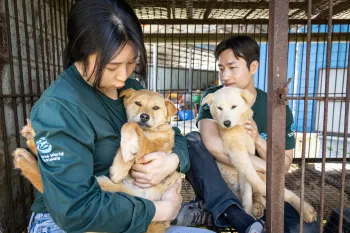
Jean Chung
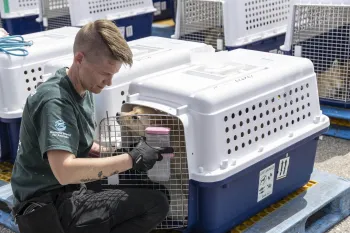
Jean Chung
When the dogs left the property, one thing really stood out to me: the silence. There was no more barking or crying for help. Only empty cages remained. Cages that would never be filled again.
Free at last, these dogs will now have the lives they deserve. After the rescue, they went straight to our care and rehabilitation center in Maryland to receive proper veterinary care with full examinations and assessments to learn more about their health and temperaments. Once they were settled and received the care they needed, the dogs were able to play with each other, get their very first toys, and accept love from our staff. Now, they are starting to go to placement partners, and soon, they will be adopted into loving homes.
Watch the full rescue story
Follow along in our exclusive behind-the-scenes video of this rescue mission.
South Korea’s historic decision to ban the dog meat industry by 2027 gives hope to thousands more dogs who suffer like this. Our rescue was one part of a much larger movement that proves change is not only possible but already underway.
Jean Chung/
Help us save more lives
This rescue was made possible by people like you. Consider donating or sharing this story to support future rescues and fight to end the dog meat trade.
Related stories
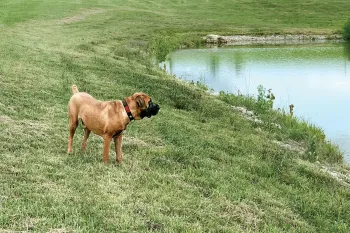
Courtesy of Joni Conley
Mir, a 130-pound Tosa, was one of nearly 150 dogs rescued in October 2019 from a South Korean dog meat farm—the 17th closed by Humane World. Now, with his loving family, Mir revels in a different kind of farm life.
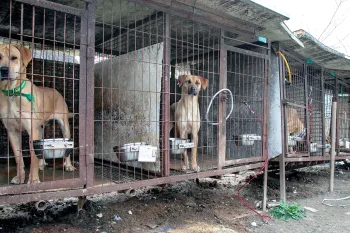
Jean Chung/HSI
To ensure South Korea's dog meat ban is effective, we’re increasing public support for the ban during the phase-out period. And we’re focused on humane management of the remaining dogs still in the industry.
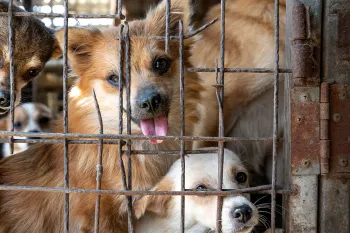
Jean Chung/Humane World for Animals
Dogs and cats are our loyal companions, but in some parts of Asia and Africa they are killed for human consumption in a trade that is not only immensely cruel but also poses a threat to human health through the spread of deadly diseases such as rabies.
